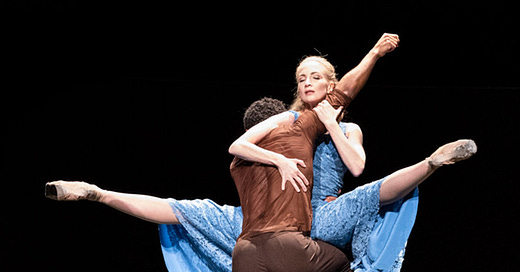Repost: The Cellist
With the Royal Opera House’s recent revival of Cathy Marston’s The Cellist, I thought I would repost, with a few amendments, a review that I wrote in February of 2020, just before the pandemic.
It was a challenge to find tickets to The Cellist. By the time I found out about this new, original ballet by Cathy Marston at the Royal Opera House in London, the first two performances were sold out. But, after many attempts at refreshing the page, I was able to snag a seat in the highest balcony level.
The Cellist is based on the life of Jacqueline du Pré. It traces the musician’s tragically short career — from her first introduction to the cello by her mother, to her relationship with conductor Daniel Barenboim (expertly danced by Matthew Ball), to her debilitating, life-ending illness. (While Marston herself is not a cellist, her mother had MS.)
The minimalist set by Hildegard Bechtler simultaneously evokes the inside of a cello and the interior of a modern concert hall. The score, by Philip Feeny, ties in themes from du Pré’s most famous repertoire, including the Elgar cello concerto. Though well-done from a technical standpoint, I found the score at times too cloying, and wished the composer had done something more experimental than directly quoting from old favorites.
Principal cellist Hetty Snell — mostly invisible during the ballet, as she was tucked into the orchestra pit — played beautifully. It’s no easy task filling the shoes of one of the greatest cellists in history. Snell was the real star of the show, which did not go unnoticed, as evidenced by her raucous applause at curtain call.
Du Pré’s instrument (yes, you read correctly) was played by dancer Marcelino Sambé, wearing an all-brown outfit, whose movements are so fluid and sensual that they really did evoke the varnished curves of a cello. (Though I wondered about the decision to cast him as the only dancer of color.) When the cellist, played by the supremely talented Lauren Cuthbertson, “plays” her instrument, she stands behind him, knees slightly bent, using his left arm like a fingerboard, and moving her right arm in a bowing motion.
While this dance is conceptually interesting, it is not perhaps the most elegant, and the viewer is relieved when Sambé and Cuthbertson break free of the mime and perform a more abstract interpretation. As the dancers bow and twist around each other, it becomes less clear who is “playing” whom. Even in the scenes where Matthew Ball dances, he appears almost a third wheel to Sambé and Cuthbertson’s amazing chemistry.
The act of “playing” another human being like a cello in a performance setting is, surprisingly, not without precedent. Whether or not Marston isaware of the connection, her ballet evokes the collaborations between cellist Charlotte Moorman and artist Nam June Paik in the 1960’s, specifically the work “Human Cello,” in which Moorman “plays” a shirtless Paik, string stretched across his back, to the “tune” of John Cage. (Also see the bizarre and disturbing 1970s Italian film Il Merlo Maschio.)
Aside from this cultural significance, many aspects of the choreography were remarkably subtle. At the beginning of the ballet, when the young du Pré is played by the precocious Emma Lucano, the duet between between Lucano and Sambé has an air of awkwardness owing to their relative sizes. It is as if the cellist has not yet grown into her instrument.
Towards the end of the ballet, Cuthbertson’s shaky movements resemble vibrato, evoking the cellist’s MS, without becoming a caricature. While at first I found it strange that Cuthbertson should stand while playing, this is explained at the end of the ballet when the cellist plops into a chair, symbolizing her defeat by the illness.
Watching this ballet, I could not help but think of Powell and Pressburger’s The Red Shoes. Based on the story by Hans Christian Anderson, the film is about a ballerina, played by Moira Shearer, whose own ambitious career begins to mirror the ballet she is dancing in — about a pair of red ballet slippers that possess the wearer to essentially dance to her death.
The film, which also featured dancers from The Royal Ballet, similarly involves a romance with a young conductor that is only secondary to the relationship between the protagonist and her art.
While the plot of The Cellist is, obviously, different from The Red Shoes (after all, The Cellist is based on a true story, not a fairy tale), it has similar themes. Both works center around a personified object that symbolizes the protagonist’s dedication to her art. In The Red Shoes, however, the shoes are implicated in the protagonist’s death, while in The Cellist, the instrument mourns its owner.
In the final, emotional scene, the cello clutches a record and remembers du Pré as a young girl, as if saying that the virtuoso’s memory now lies in her recordings. I think the secondary message of this ballet, however, is that instruments, as witnesses to musical greatness, also carry on a legacy.
While du Pré did not actually play the Davidov Strad throughout her life, as the ballet suggests, the instrument did go on to be played by Yo-Yo Ma and several other cellists. To doctor a quote from The Red Shoes, “Time rushes by, love rushes by, life rushes by, but the cello plays on.”




